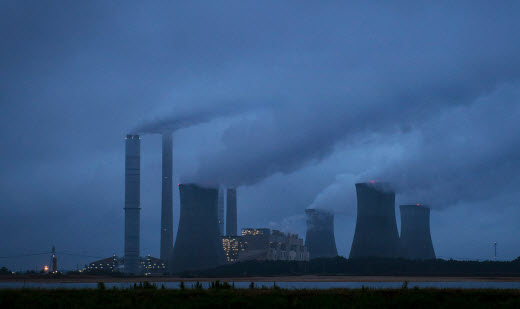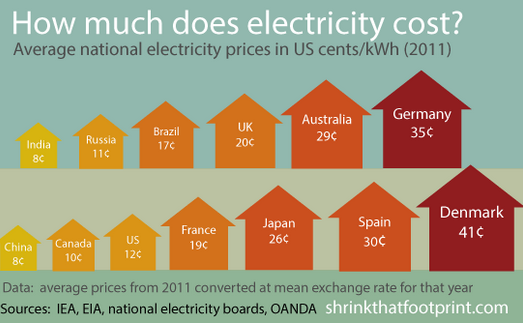States Going All Out to Nullify Obama’s Clean Power Plan
Years of court fights in the offing Aug 26 2015"Within minutes" said The New York Times. "Minutes after", said The Wall Street Journal. Both were clocking how fast after the EPA announced the "rule" for President Obama's Clean Power Plan that the attorneys general of 15 states announced their intention to file suit to block the program.
Speaking for the group, the attorney general of West Virginia, a coal mining state that will be affected more than others, said that the final rule "blatantly disregards the rule of law and … represents the most far-reaching energy regulation in this nation’s history, drawn up by radical bureaucrats and based on an obscure, rarely used provision of the Clean Air Act". For the Journal, "This abuse of power is regulation without representation. The damage to growth, consumer incomes and U.S. competitiveness will be immense".
The final EPA (Environmental Protection Agency) rule requires a 32% cut in power-plant carbon-dioxide emissions by 2030 relative to 2005 levels. That's a bit steeper than the 30% contemplated by the agency a year ago , but the 25% interim reduction originally intended for 2020 has been pushed to 2022 in consideration of the industry's concerns for the difficulty of meeting the original target.
Each state will be required to file with the EPA by 2018 its plan to meet its objective. How much each state must cut back its emissions varies according to what it emitted in the benchmark year of 2005. Each state will be free to develop its own plan employing a mix of solutions from power plant fixes to wind and solar renewables and even state or regional markets for trading pollution permits commonly called “cap-and-trade”. That last method worked spectacularly well in an alliance of northeastern states to reduce acid rain, yet its advocacy is curiously muted, because somewhere along the years, lawmakers inexplicably turned up their nose at what is, after all, a market-based approach.
The final rule gives existing nuclear plants more credit for having already contributed to the goal because they emit no CO2. Efficient use by customers was removed as a measure of emission reduction; the industry objected because utilities can't dictate habits. The EPA made a big change for renewables. Once just one of the options, the agency has decreed that they must constitute at least 28% of the energy mix by 2030. Nationally, renewables accounted for 13% of energy production last year.
to the barricadesFive Republican governors so far have said they will defy the regulations, including two presidential hopefuls, Scott Walker of Wisconsin and Bobby Jindal of Louisiana. The others are Greg Abbott of Texas, Mike Pence of Indiana and Mary Fallin of Oklahoma. In a letter to Obama, Walker wrote of the “staggering costs it would inflict on Wisconsin’s homes and businesses,” that “it is difficult to envision how Wisconsin can responsibly construct a state plan.” Scott Pruitt, Oklahoma's attorney general, is petitioning for a preliminary injunction against the Clean Power Plan based on a 1958 Supreme Court precedent in Leedom v. Kyne in which "an agency exceeds the scope of its delegated authority or violates a clear statutory mandate”.
It was Mitch McConnell who set the protest movement in motion when in March he sent letters to all 50 governors urging them to ignore the EPA 
program and its requirement to submit an emission reduction plan. It was not simply an unusual action but an abuse of his position as Senate Majority Leader, which carries the implicit threat to states that if they don't march to his commands, there could be payback in what laws do or don't get passed.
Back then, The New York Times reported McConnell "coordinating with lawyers and lobbying firms to try to ensure that the state plans are tangled up in legal delays". By when Obama announced the plan, "the small group that had begun its work at [the pro-business lobby] the Chamber of Commerce had expanded into a vast network of lawyers and lobbyists ranging from state capitols to Capitol Hill, aided by Republican governors and congressional leaders".
McConnell's efforts are aided by the American Legislative Exchange Council, or ALEC. A conservative advocacy group, ALEC's business is to spoon feed model legislation to state legislatures for them to vote into law. Their lawyers have drafted two model bills for the roughly two-thirds of state legislatures now under Republican control. In one, although state environmental agencies have for decades worked directly with the EPA on Clean Air Act matters, ALEC proposes that a state's agency must now seek the state legislature's approval of any emission reduction plan before submitting it to the EPA. The second bill requires as well that all legal challenges be resolved before any submission, the intent clearly being to endlessly delay any submission with fabricated challenges.
If a state doesn’t produce a plan, the EPA would impose one, but that raises the question of how can the federal government enforce compliance other than by withholding funds? Additional to the legal challenges to the EPA's rule, non-compliance promises to be a second front that will be fought in the courts for years to come. We would return to John C. Calhoun and his advocacy of "nullification" under which states could declare null and void federal laws that they viewed as unconstitutional. The Wall Street Journal's editorial page is all for it.
"States can help the resistance by refusing to participate. The Clean Air Act is a creature of cooperative federalism, and Governors have no obligation to craft a compliance plan. The feds will try to enforce a fallback, but they can’t commandeer the states, and they lack the money, personnel and bandwidth to overcome a broad boycott. Let’s see how much “clean power” the EPA really has.
Of course, if a Republican wins the White House, he or Ms Fiorina could simply halt the entire reform.
For the moment the Obama administration has the upper hand. The Supreme Court ruled in 2007 that carbon dioxide (CO2) is a pollutant subject to EPA control under the Clean Air Act of 1970, and has upheld the EPA’s authority to curb CO2 three times in the previous seven years. Early this year, it ruled 6-2 that 28 Midwestern and Appalachian states are subject to EPA's cross-state air pollution rule that limits power plant emissions blown into downwind Northeastern states. And just this June, a federal court dismissed a suit against the EPA by the nation’s largest coal company and 14 coal-producing states that sought to halt the Clean Power Plan. That will of course be appealed.
power downFaced with shutting down older coal-fired plants not worth retrofitting, the power industry says it will also have to write off billions of debt stilled owed for the building of newer facilities. Moreover, the renewable mandate requires billions of dollars for transmission lines to bring in solar and wind power, and pipelines to feed natural-gas to replacement power plants.
But the power industry has had a long run with coal, first used for electricity 130 years ago, and has successfully fought off retrofitting pollution controls one administration after another (when George W. Bush and Dick Cheney took office, they aborted 51 suits by the Clinton administration that would have forced pollution controls much sooner than now).
the negativesThe Clean Power Plan will cost "hundreds of thousands of jobs" (says the Heritage Foundation), electricity customers will see steep rises in their monthly bills when the cost of conversion to other than coal is passed on to them, and taking coal-fired plants out of service could result in brown outs or worse. Those are the arguments that you will be hearing in the years to come from the power industry and politicians in their keep.
There are not hundreds of thousands of jobs to lose. Coal mining has been in steady decline, down to 80,000 jobs in 2013, and there are 60,000 others who work in power plants. These are significant numbers, but all coal power plants will of course not be shut down, and for the rest, how is the nation to progress from a 19th century technology (450,000 coal miners in 1900) if we are forever anchored to preserving these particular jobs. The same faction that now anguishes over coal mining jobs had no problem with exporting an estimated 6 million manufacturing jobs when they championed globalization and free trade.
Moreover, as should be obvious, the building of new plants and the conversion of old ones to natural gas, plus the infrastructure build-out for alternate energy sources such as wind and solar, are what will create the hundreds of thousands of jobs. Clean energy now delivers three times as many jobs per dollar invested as fossil-fuel investments.
Yes, electricity charges will rise — significantly in areas still heavily dependent on coal for power generation and therefore with the most to do to meet new standards.
The White House claims families will save $85 on their annual power bills by 2030, which, even if possible, evades what those families will be paying in the interim. Additional to the conversion costs passed through to customers, the new systems can only be less efficient once on line. Sun and wind are intermittent, and must be backstopped by fossil-fuel plants, "which must be cycled up and down depending on whether the wind is blowing or the sun is shining", explains The Wall Street Journal. "This cycling reduces efficiency for the backup coal and gas plants in much the same way as stop-and-go driving cuts automotive fuel efficiency". That will add to cost.
Simultaneously, though, it is easy for a homeowner to cut energy bills with more conscientious use. And the Internet of Things is coming on strong to 
We should recognize that electricity in the U.S. is cheap. Ask the rest of the world. We've been spoiled.
give us the smart meters that constantly adjust use by time of day and presence or absence of people in the home. The steady decline in the cost of solar will find us outfitting our houses to sell power back to the utilities. Capturing the Sun's energy with our rooftops makes for a revolution in energy.
Reliability is a valid issue. The national electrical grid of 3,200 utilities that deliver power over 2.7 million miles of power lines is the most essential of all industries — what Bloomberg/BusinessWeek called "the largest machine in the world". Conversion is complex and disruptive. Reworking the grid to "pick up" gas, wind and solar wherever it is found will be a nightmare of permits and eminent domain takings. Changing the power grid is a generational matter.
But the nation can't stand still. Strengthening the fragile and vulnerable grid is essential. Much as we see nothing done while other infrastructure collapses, we will now witness a protracted fight waged by those who insist on holding the nation back from progress.
Please subscribe if you haven't, or post a comment below about this article, or
click here to go to our front page.

